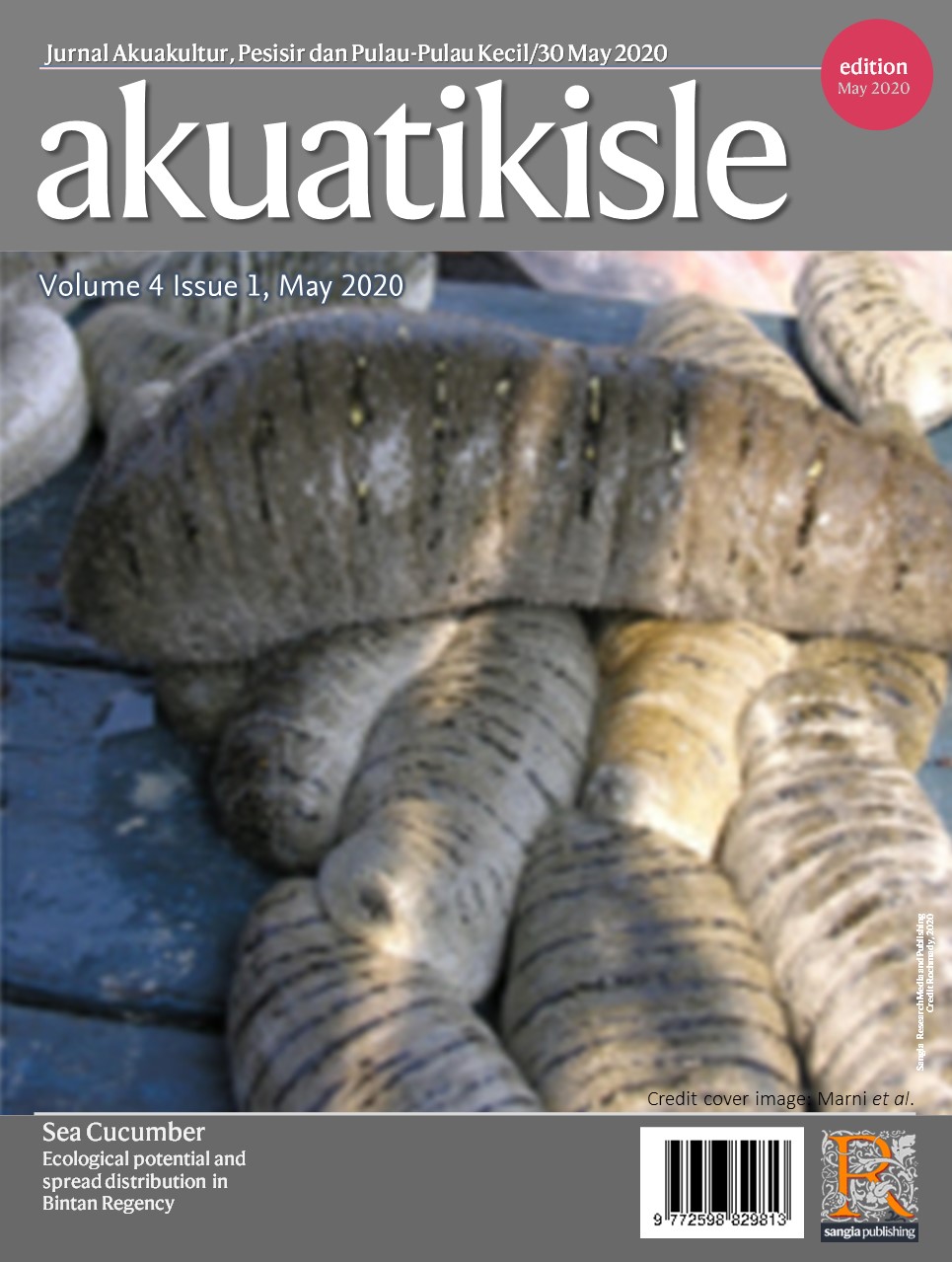Akuatikisle: Jurnal Akuakultur, Pesisir dan Pulau-Pulau Kecil
Full Length Article
Effectiveness of clove oil as anesthesia of Sergeant Major Abudefduf vaigiensis (Quoy & Gaimard, 1825)
Highlights
Generate NLP AI by Wizdam ID.
Abstract
The increasing demand for live ornamental fish for export needs triggers fishermen to start looking for alternative fishing techniques that are more effective and efficient. The technique commonly used is the anesthetic technique using potassium cyanide. The use of cyanide has been banned by the government because of the many impacts it has caused such as the degradation of coral reef ecosystems, high non-target fish mortality and pollution of coastal areas. Clove oil is an alternative anesthetic which can be utilized with many advantages compared to cyanide. The sampled fish used was sergeant major (Abudefduf vaigiensis) as many as 15 fish with a size of 9-12 cm obtained from fishermen's catch using a scoop. The purpose of this study was to determine the optimal concentration of clove oil as an anesthetic of Sergeant Major Fish (Abudefduf vaigiensis) based on induction time and recovery time. The experimental design used was a Completely Randomized Design (CRD). Analysis of the data used is One-Way ANOVA parametric analysis and Kruskal Wallis nonparametric analysis. The results obtained are five series of concentrations (20 ppm, 30 ppm, 40 ppm, 50 ppm, 60 ppm) which have a significant effect on induction time (20 ppm and 60 ppm) of sergeant major fish (Abudefduf vaigiensis) (P<0.05) The treatment of five concentration series (20 ppm, 30 ppm, 40 ppm, 50 ppm, 60 ppm) did not have a significant effect on the recovery time of the Sergeant Major Fish (Abudefduf vaigiensis) (P>0.05).
Abstract
The increasing demand for live ornamental fish for export needs triggers fishermen to start looking for alternative fishing techniques that are more effective and efficient. The technique commonly used is the anesthetic technique using potassium cyanide. The use of cyanide has been banned by the government because of the many impacts it has caused such as the degradation of coral reef ecosystems, high non-target fish mortality and pollution of coastal areas. Clove oil is an alternative anesthetic which can be utilized with many advantages compared to cyanide. The sampled fish used was sergeant major (Abudefduf vaigiensis) as many as 15 fish with a size of 9-12 cm obtained from fishermen's catch using a scoop. The purpose of this study was to determine the optimal concentration of clove oil as an anesthetic of Sergeant Major Fish (Abudefduf vaigiensis) based on induction time and recovery time. The experimental design used was a Completely Randomized Design (CRD). Analysis of the data used is One-Way ANOVA parametric analysis and Kruskal Wallis nonparametric analysis. The results obtained are five series of concentrations (20 ppm, 30 ppm, 40 ppm, 50 ppm, 60 ppm) which have a significant effect on induction time (20 ppm and 60 ppm) of sergeant major fish (Abudefduf vaigiensis) (P<0.05) The treatment of five concentration series (20 ppm, 30 ppm, 40 ppm, 50 ppm, 60 ppm) did not have a significant effect on the recovery time of the Sergeant Major Fish (Abudefduf vaigiensis) (P>0.05).
Keywords
Introduction
Section snippets
Material and Methods
Materials and methods from the full-text PDF of this article cannot be displayed.
Results
Results from the full-text PDF of this article cannot be displayed.
Discussion
Discussion from the full-text PDF of this article cannot be displayed.
Conclusions
Conclusions from the full-text PDF of this article cannot be displayed.
Acknowledgment
Acknowledgment from the full-text PDF of this article cannot be displayed.
Competing interest
The authors declare that they have no known competing financial interests or personal relationships that could have appeared to influence the work reported in this paper.
Conflict of interest
The authors declare that the research was conducted in the absence of any commercial or financial relationships that could be construed as a potential conflict of interest.
Ethical approval acknowledgements
No ethical approval required for this article. All procedures followed were in accordance with the ethical standards of the responsible committee on human experimentation (institutional and national) and with the Helsinki Declaration of 1975, as revised in 2008 (5)
Supplementary files
Data sharing not applicable to this article as no datasets were generated or analysed during the current study, and/or contains supplementary material, which is available to authorized users.
Bibliographic Information
Cite this article as:
-
Submitted
11 February 2020 -
Revised
22 April 2020 -
Accepted
22 May 2020 -
Published
31 May 2020 -
Version of record
27 June 2020 -
Issue date
31 May 2020
-
Academic subject
Fisheries; Fisheries Science
Copyright
Copyright © 2020 Ainun Ayu Utami Amris, Sri Wahyuni Rahim, Khusnul Yaqin. Sangia Research Media and Publishing. Production and hosting by Sangia (SRM™).  This work is licensed under a Creative Commons Attribution-ShareAlike 4.0 International License.
This work is licensed under a Creative Commons Attribution-ShareAlike 4.0 International License.
Disclaimer: All claims expressed in this article are solely those of the authors and do not necessarily represent those of their affiliated organizations, or those of the publisher, the editors and the reviewers. Any product that may be evaluated in this article or claim that may be made by its manufacturer is not guaranteed or endorsed by the publisher.
Comments on this article
By submitting a comment you agree to abide by our Terms and Community Guidelines. If you find something abusive or that does not comply with our terms or guidelines please flag it as inappropriate.



